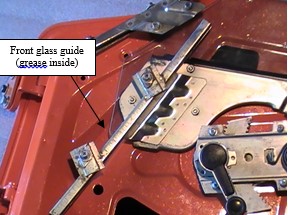CREDITS: This article was initially written by Enrique Scanlon in 2004. With his help, Bob Kroshefsky (Seppi72) revised it in 2011 while working on his own car.
You can perform troubleshooting with the door on or off the car. Various parts and sources are listed at the end.
Window movement problems can be caused by:
- a bent regulator arm,
- a bent or misaligned front or rear guide,
- a sticking or broken roller,
- a stripped handle or
- a damaged regulator gear.
You will first have to remove the interior door finisher panel to expose the door innards. The picture below shows all the parts discussed in this article laid out in their approximate positions.

Remove the door window regulator assembly (below). That's the gear and lever mechanism operated by the window crank. This will allow you to both inspect it easily and manipulate the window within the door without this assembly getting in the way.

Check the main door sash – the stainless steel (SS) window frame. Is it straight? There is a gentle inward curve to it that allows the glass, which isn't flat itself, to slide up and down inside of it. But other than the gentle curve, is the sash itself straight, i.e., no twists, kinks, dings, or anything that would stop the glass from going up and down?
The felted gasket inside the main door sash should have a uniform profile of constant width. If the gasket has lost a lot of its felt lining, it will act just like solid rubber on the glass, preventing the window from moving up and down smoothly. I don’t know of a way to restore these so you’ll have to replace them. One other thing: the Datsun parts microfiche indicates there is a second felted gasket for the lower rear sash. In all the S30 doors I have taken apart over the years, I’ve never seen this piece and I’m not sure how useful it might actually be, although I know that the lower rear corner of the glass rides in this part of the sash channel. Regardless, the part is listed at the end of this article.
Slide the window glass up and down inside the main door sash. You should be able to determine if the window will go up and down smoothly and effortlessly (considering the weight of the glass pane). If it passes this test, then you know that the sashes and guides are set up properly and the glass gaskets are OK. If, on the other hand, you find that the window sticks either on the way down or on the way up, address the problem.
Is the door glass bumper pressing on the window pane properly? This is the little, barrel-shaped roller that guides the pane into the upper part of the door sash. There should be one of these near the front of the door and, as an option, a second one near the back. There are cutouts on the inside of the exterior door sheet metal where these bumpers need to go. They sit underneath the SS/rubber exterior trim piece. The metal portion is formed of spring steel and is highly susceptible to both corrosion and fatigue breakage at the various bends put into the part.




The bumper is required to push the glass inward at the bottom of its travel. The interior door finisher panel’s fuzzy weatherstrip pushes the window outwards. Between these two, along with the main sash and the front guide, the glass is maintained in the middle of the imaginary window channel surface and the glass operates nicely.
Check the front glass guide that’s bolted to the inner door panel sheet metal. The nylon slide mounted on the front of the glass support frame rides in this channel. Is the slide moving smoothly? Will lubrication take care of it? The guide has a gentle curve to it like the main door sash, but the channel itself should not have any noticeable bends in it. If it does, it must be repaired or replaced. This is more than likely the source of any operating problem.


Check the regulator arms (the scissors) to see if they're straight. Only one has a bend to it and it is noticeable and obviously intentional. Next, check the regulator pinion gear (that the crank handle actuates) and the toothed spline arm. If any teeth are missing or bent, this will cause a hitch in movement. If it’s the pinion gear, problems will be cyclical. If it’s the stamped metal spline, a problem will only occur once as the window operates. Is the toothed portion of the spline arm flat and making proper contact on the pinion gear?


There should be a coil spring on the regulator assembly. It's there to exert force upwards on the glass to counter its weight. If it's unanchored, broken or missing then raising the glass is going to be extremely difficult. The sheer weight of the pane is too much for the gearing in the regulator and the pinion gear will work its way out of the spline arm teeth.
Check the roller wheels on the regulator arms. Two of them act directly on the window pane itself and the third fits in the rear regulator guide that is bolted to the inner sheet metal panel of the door. Each of these wheels MUST roll easily. What I mean is that they don't spin freely, but will spin with a little force. If they aren't moving easily, then you must clean them out and free them up; perhaps adding some sort of lubricant. Make sure they operate without wobbling on their axles. If they have a lot of wobble, they will probably jam as you exert force on the wheel through that axle. If these rollers are broken, tight or otherwise NOT functioning properly, because they are at the end of long arms, the problem gets magnified. The rollers are nylon and can easily become grooved or damaged. If that's the case, the only way to fix this is to get a new window regulator assembly as the pins that hold the rollers to the scissor levers are peened into the lever arm.

If the roller wheels check out OK, are the two guide channels on the glass support frame (the metal attached to the glass itself) straight and unbent or undamaged? These channels are what the door window regulator assembly wheels ride in and exert the force to raise and lower the glass. If there are kinks, gunk or other obstructions, they will cause you problems. They must be uniform in channel width; that is, the width that the roller "sees" as it rolls back and forth. As you look down the channel from the end, it should be smooth and straight. Check for old grease residue. Old grease eventually gets to be the consistency of tar and makes it VERY difficult to move items through it.

BTW, the only places for grease on the window assembly are on (1) the front glass guide, where the glass support frame’s nylon slide goes, (2) the regulator gear/spline contact area, (3) the swivel point for the regulator arms, (4) the two channels on the glass support frame and, (5) the rear regulator guide. Other than that, no grease, oil or other lubricant is needed. You should NEVER apply grease anywhere in the main door sash. Grease here will just get all over your arm or shirt sleeve. And, God help you if that happens to your wife or girlfriend.
The adjustment for the window is straightforward. You have to have the door glass bumper(s) installed or it will be a royal PITA. The interior weatherstrip on the door finisher panel, presses against the glass to push it out. If it's missing or caked solid with dirt, grease or gunk, it will just impede the sliding of the pane. The fuzzy rubber gasket on the exterior SS trim piece seals the door innards from rain once the window is closed. The bumper locates the glass in the center of the main door sash.
1. If off the car, make sure that the door panel is vertical.
2. Loosen the installation nuts for the front door sash and the rear regulator guide.
3. Roll the window up and down and check the alignment of the rear edge of the glass with the main door sash.
4. If the glass tilts too far to the rear, move the rear regulator guide upward. If it tilts too far to the front, move the guide downward. As a general rule, the guide nuts will both be at the same location respective to each other within their slotted holes; i.e., the front nut won't be higher or lower than the rear nut in the inner door panel slots.
5. When the glass is parallel with the main door sash, adjust the front glass guide so it is parallel with the front edge of the window. You can just look down from above and ensure that the nylon slide on the window pane frame is going to go up and down smoothly within the front glass guide.
The part numbers listed below were verified in 2011 but the availability from any commercial vendor is not assured. Obviously, Black Dragon went away after we wrote this article. All parts listed are those for the 1972 model year (MY) although some may fit all S30 model years. Check with the vendor to make certain you’re getting the right part for your car.
Part Descriptions Part Numbers Sources
LH Universal RH
Upper sash channel felted gasket 80335-E4102 Nissan
(sash above the door panel) 59-870 Black Dragon
Lower sash channel felted gasket 80336-E8700 Nissan
(lower rear sash inside door panel)
Window regulator 80701-N3001 80700-N3001 Nissan, CZCC members, eBay, boneyards
Door glass bumper 80841-E4101 80840-E4101 Nissan
30-2151 30-2150 MSA
Front glass guide 80211-N3400 80210-N4200 Nissan, CZCC members, eBay, boneyards
Rear regulator guide 80710-21000 Nissan, CZCC members, eBay, boneyards
Glass support frame 80303-E4100 80302-E4100 Nissan, CZCC members, eBay, boneyards
Interior weatherstrip 80846-E4100 80845-E4100 Nissan
59-731 Black Dragon
34-1058 34-1059 MSA
Exterior trim piece 80821-N4401 80820-N4401 Nissan, CZCC members, eBay, boneyards
(varies by MY, so check) 59-798 59-799 Black Dragon
34-1120 34-1121 MSA







Recommended Comments
There are no comments to display.
Create an account or sign in to comment
You need to be a member in order to leave a comment
Create an account
Sign up for a new account in our community. It's easy!
Register a new accountSign in
Already have an account? Sign in here.
Sign In Now